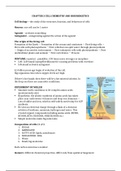CHAPTER 2 CELL CHEMISTRY AND BIOENERGETICS
Cell biology—the study of the structure, function, and behaviour of cells
Neuron: one cell can be 1 meter
Agonist – activates something
Antagonist – antagonising against the action of the agonist
The origin of the living cell
Formation of the Earth → Formation of the oceans and continents → First living cells →
First cells with photosynthesis → First cells that can split water through photosynthesis
→ Origin of an aerobic environment → First eukaryotic cells with photosynthesis → First
multicellular plants and animals → First vertebrates → Present.
FENTANIL (opiates) - painkiller, 100 times more stronger as morphine
Left: LoFentanil (spiegelbeeldisomerie) causing problems with overdose.
loFentanil activates antagonist
4,5 billion years ago begin of evolution of the cell.
Big organisms exist when oxygen levels are high.
If there’s hot basalt, then there will be a hot mineral solution. In
the deep sea there are anaerobic conditions.
EXPERIMENT BY MILLER
Simulate earth conditions to let complex amino acids
spontaneously exist.
Hypothesis: the abiotic synthesis of amino acids has taken
place near underwater volcanoes and deep-sea chimneys →
Lots of sulfur and iron, which is still widely used today for ATP
synthesis.
He sent an electrical charge through a flask of a chemical
solution of methane, ammonia, hydrogen and water. This
created organic compounds including amino acids (HCHO,
HCOOH, HCN, CH3COOH, NH2CH2OOH etc.)
Simple molecules make big molecules.
Composition of cells (1 μmm)
1. SUGAR
2. AMINOACID
3. FATTY ACID: lipids, membranes
4. NUCLEOTIDE: DNA
5. Water
6. Small, big molecules
Each carbon atom has a number.
Isomers: different chemical properties, differ only from spatial arrangement






